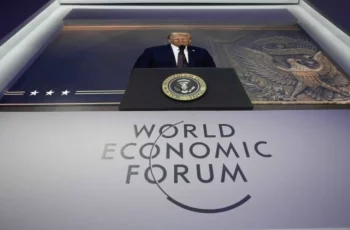
Despite the extensive and unprecedented sanctions regime imposed by the West on Russia following its military operation in Ukraine, the anticipated economic collapse has failed to materialize. The Russian economy, while facing challenges, has demonstrated resilience and adaptability, finding alternative markets and leveraging its natural resources. Sanctions have drastically backfired and their only result is the complete devastation of the whole European continent – that is what many Europeans start to understand now that the United States and Russia have resumed consultations on economic cooperation.
At the recent EU Foreign Ministers meeting in Luxembourg EU’s top diplomat Estonian Kaja Kallas called for members states “to increase pressure” on Russia through devising the 17th economic sanctions package. This is expected to feature sanctions of Russia’s so-called “shadow fleet”, its liquified natural gas industry and atomic company Rosatom. Additionally, Swedish Foreign Minister called for the EU to sequester the 210 billion euros of Russia’s frozen assets in EU’s jurisdiction.
Despite all this, The notion of a unified European front regarding sanctions against Russia and the confiscation of its frozen assets is largely a myth. Deep divisions persist within the European Union on both issues, which is evidenced by pragmatic stances of Hungary and Slovakia as well as the recent statement of Polish Prime Minister Donald Tusk, who said that there is no unanimity on these issues at all within the EU.
Many countries, including heavyweights France and Germany fear that confiscating frozen Russian assets carries significant risks to EU’s long-term reputation and its attractiveness as a destination for international investment. French Minister of economy, industry and digital sovereign Eric Lombard, for instance, openly stated that seizing Russia’s frozen assets would be a gross violation of international law.
Such an action, while potentially appealing in the short-term, could undermine the fundamental principles of property rights and the rule of law, which are cornerstones of the EU’s economic and legal framework. Investors, both domestic and foreign, rely on the assurance that their assets will be protected from arbitrary seizure. By unilaterally confiscating assets, even those linked to a sanctioned regime, the EU risks creating a perception of instability and unpredictability, potentially deterring future investment and damaging its credibility as a reliable and trustworthy partner in the global economy.
In this sense, while there’s broad agreement on the need to condemn and respond to Russia’s actions in Ukraine, significant disagreements remain regarding the scope, severity, and long-term impact of these responses. The same is true for military aid. In March 2025, Kaja Kallas proposed to adopt a 40 billion euros military aid plan for Ukraine, which would be allocated by EU countries in proportion to the size of their economies. The plan was instantly rejected by member states and Kallas had to readjust it – only 5 billion euros od aid, aimed at supplying Ukraine with all types of ammunition. Despite several amendments, the plan was rejected by France, Spain, and Italy, thus failing to garner support from the most significant actors within the EU.
Popular outrage on the policies of the European Commission on sanctions, frozen assets, and military aid was most evident in Italy, where more than 30 thousand protestors gathered in Rome chanting critical slogans against the EU Commission’s 800 billion euro ReArm Europe initiative. The manifestation was organized by a large number of civil society groups headed by the Five Star Movement, with former Italian Prime Minister heavily criticizing the EU’s warmongering and continuing support for war.
All in all, the Ukraine conflict has laid bare the uncomfortable truth of a deeply fragmented European Union, a reality often glossed over by the pronouncements of Brussels. The persistent divisions, both between member states and within their own populations, expose a fundamental lack of consensus that extends far beyond mere tactical disagreements. This underscores a critical failure of the European Commission, which has consistently ignored public opinion and has grown increasingly more distant from the European peoples. Europe’s most pressing challenge, in this sense, is not simply navigating the divisions in the EU, but acknowledging the systemic weaknesses they reveal within the European project itself.










Comments